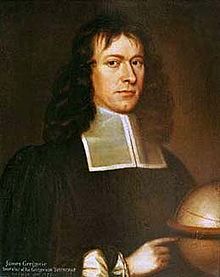James Gregory (mathematician)
James Gregory (born November 1638 in Drumoak near Aberdeen , † October 1675 in Edinburgh ) was a Scottish mathematician and astronomer . He found essential results of analysis before or at the same time as his contemporaries, but published little. In the course of his optical research he developed the Gregory telescope , which was widely used until around 1800.
Live and act
The pastor's son James Gregory was taught math and geometry from his mother at an early age. He attended Marischal College in Aberdeen, where he mainly dealt with astronomy and mathematical optics until his graduation in 1657 .
In 1663 Gregory published a book about his research in optics, the Optica Promota . In it he dealt with lenses, reflection , refraction , parallaxes and for the first time used photometric methods to estimate the distance from fixed stars. He also suggested observing the transit of Venus to determine the astronomical unit , a suggestion that was later repeated by Edmund Halley without mentioning Gregory's priority. Its most important development was the description of a mirror telescope that uses a secondary concave mirror to direct the reflected light from the primary parabolic mirror through a small hole in the primary mirror onto the eyepiece . Known as the Gregory telescope , this design was used until the 19th century.
In 1663 he found a publisher in London for his book , but no craftsman who could have made the necessary mirrors for his telescope. Robert Hooke only succeeded in doing this ten years later .
From London in 1664 Gregory traveled via Paris to Padua , where he worked in collaboration with Stefano degli Angeli (1623–1697) on the calculation of circular and parabolic areas using infinite convergent series . There the book Vera circuli et hyperbolae quadratura was written in 1667 , in which he dealt with the fundamentals of differential calculus , and Geometriae pars universalis (1668), which contains the first known proof of the main theorem of analysis . In the same work he tried to estimate the unknown distances of bright stars. For Sirius , a photometric comparison with the Sun and Jupiter gave him 1.25 light years (instead of 8.6 LJ), but for the first time the order of magnitude was correct.
On his return to London in 1668 he was appointed a Fellow of the Royal Society and in the same year received the Regius Chair in Mathematics at the University of St Andrews, which was specially set up for him . What is certain is that this summer he was familiar with the Taylor series of sines and cosines as well as the tangent . The latter opened up new ways of calculating the district number . A year later, in St Andrews, he married Mary Jamesome, who has two daughters and a son.
Other important achievements followed in St. Andrews, such as the independent discovery of the Taylor formula in 1671 , which Brook Taylor himself did not publish until 1715. Much of this work can only be found in letters to colleagues, as Gregory published very little after a plagiarism dispute with Christiaan Huygens .
James Gregory discovered the diffraction of light by bird feathers and investigated the diffraction patterns that occur.
After lengthy disputes with colleagues and the university management in St. Andrews, which even banned his salary for a time, Gregory followed in 1674 a call to the newly established chair of mathematics at the University of Edinburgh . A year after his call, he suffered a stroke while observing the moons of Jupiter , which he died a few days later.
James Gregory was the grandfather of the philosopher John Gregory and the uncle of the mathematician David Gregory .
In 1970 the crater Gregory was named after him.
literature
- James Gregory: Vera Circuli Et Hyperbolæ Quadratura. Patavii 1667, Heredes Pauli Frambotti Bibliop.
- Herbert Westren Turnbull (Ed.): James Gregory Tercentenary memorial volume . London 1939
- Max Dehn , Ernst Hellinger : Certain mathematical achievements of James Gregory. In: American Mathematical Monthly. Volume 50, 1943, pp. 149-163
- Joseph Ehrenfried Hofmann : About Gregory's systematic approximations for the sector of a center conic section . In: Centaurus , 1 (1950), pp. 24-37
- Horst Hischer : James Gregory and “Convergence” - on the trail of his algorithm. In: Krohn, Thomas & Schöneburg, Silvia (Ed.): Mathematics from then for now . Hildesheim: Franzbecker 2016, pp. 61–86, ISBN 978-3-88120-762-1 ; also online as preprint .
Individual evidence
- ^ Penny Pirie-Gorden (2006) A Portrait of James Gregory , FRS ; The Baronage Press Ltd, London; accessed on November 27, 2015.
- ↑ Letter from James Gregory to John Collins, dated 13 May 1673. Reprinted in: Correspondence of Scientific Men of the Seventeenth Century .... , ed. Stephen Jordan Rigaud (Oxford, England: Oxford University Press , 1841), vol. 2, pages 251-255; see especially page 254. Available on-line at: Books.Google.com .
- ↑ James Gregory (mathematician) in the Gazetteer of Planetary Nomenclature of the IAU (WGPSN) / USGS
Web links
- John J. O'Connor, Edmund F. Robertson : James Gregory. In: MacTutor History of Mathematics archive .
- Spektrum.de: James Gregory (1638–1675) September 1, 2015
| personal data | |
|---|---|
| SURNAME | Gregory, James |
| BRIEF DESCRIPTION | Scottish mathematician and astronomer |
| DATE OF BIRTH | November 1638 |
| PLACE OF BIRTH | Drumoak near Aberdeen |
| DATE OF DEATH | October 1675 |
| Place of death | Edinburgh |


